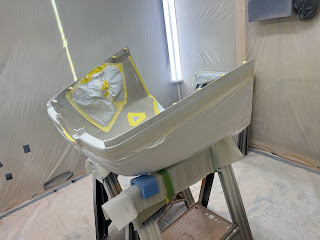To clean out the fiberglass fuel tanks and also ensure there is no uncured resin, we used the clean-out method recommended by the factory. Basically, add 1 gallon of lacquer thinner to the tank (ensuring all openings are sealed), swish around in the wing while turning and tilting it to ensure all surfaces of the tank get wet (about 30-40 seconds), then remove cap to release pressure as it builds quickly. Drain and repeat with 2nd gallon. Drained fluid should be clearer. Drain and repeat with 3rd gallon. This 3rd gallon comes out clear, so it is saved for use on the 2nd wing. This process was then repeated on the 2nd wing. A total of 5 gallons of lacquer thinner was required using this method.
 |
Michael sealing fuel port in prep for fuel tank cleanout
|
During a final test fit of the windshield, we found that some of the attachment screws could catch the sides of the holes in the windscreen. Since this could lead to eventual cracking of the windshield, we carefully enlargened the holes for better clearance by using a Dremel tool with a cylindrical bit.
 |
| A few holes in plastic windscreen enlargened |
A green stripe (3M light green material) was applied to the side of the fuselage between the white and orange paint. We like the look and plan on adding this stripe material to the wings, cowl, and control surfaces that have both orange and white.
 |
| Green stripe added to sides of fuselage |
The fuel caps need to be vented, so we disassembled the fuel cap and drilled a 3/16" hole in the top and bottom sections of each fuel cap. We then upsized the hole to 1/4" in the upper fuel cap, but only to half the depth. The fuel vent tubes were cleaned and epoxied into the 1/4 inch holes.
 |
| Hole drilled in top of fuel cap |
 |
| Vent tubes epoxied into the fuel caps |
We decided to spray black Plasti-dip on the seat position latch handles. After masking off most of the base, the T-handles were sprayed with about 6 coats. Hours: 13
 |
| Plasti-dip on seat position latch handles |




























